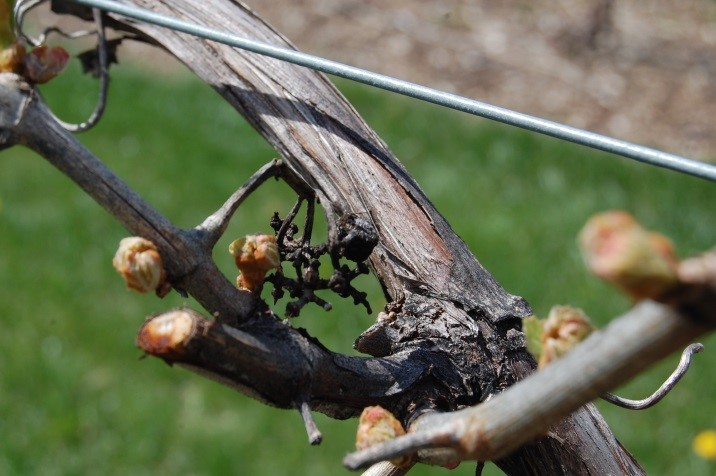Black Rot Management in the Early Growing Season
Disease scouting for the 2016 year is officially underway in the pathology research vineyards. WMARS was scouted for the first time on May 5th, and PARS will be scouted starting around the 15th. We are just past bud break at WMARS, and no disease symptoms have been observed. However, healthy buds and early shoots in the spring do not mean that disease-causing pathogens are not present. As weather warms and spring rains arrive, the overwintering bodies of various vineyard pathogens are also becoming active. One pathogen that is now active in most of Wisconsin that can cause serious loss if not controlled in the early season is the black rot fungus.
Black rot (Guignardia bidwellii) can infect all areas and stages of growth on grapes, but is particularly known for its ability to destroy clusters by infecting and later mummifying berries. This mummification process turns the berry into an overwintering structure used to house its sexual and asexual spores, which are released the following spring over the course of several weeks. While this disease is capable of causing foliar damage, it is most widely recognized for its ability to severely reduce fruit yield in vineyards, and control strategies revolve around protecting the clusters from damage. Black rot can be a challenging disease to manage, particularly to new growers, for a variety of reasons.
Firstly, black rot remains latent (inactive) after initially infecting fruit. This means that although infection can occur at bloom or any time during early fruit development, fruit symptoms do not show up until between bunch closure and veraison. An apparently promising fruit set early in the season can quickly turn into a significant loss when protectant fungicides are neglected and black rot is active. By the time symptoms appear in clusters, no control measures are possible.
Secondly, fruit have a long period of susceptibility, with peak susceptibility between bloom and about 4 weeks post-bloom. This means that the most crucial window for protecting grapes against black rot begins immediately pre-bloom and continues through early fruit development. A late start on the season can be costly when the black rot pathogen is present in a conducive environment.

Finally, black rot has a cumulative effect in vineyards. This means that the disease builds in level over time, and that newer vineyards tend to have minimal levels of infection. This differs from other annual concerns such as downy mildew and powdery mildew, which can cause outbreaks in a single season and tend to be visible each year. New growers or owners of young vineyards may not see heavy black rot pressure in the early years of vineyard establishment. As a result, black rot may be forgotten or missed for several years, building up in the vineyard, and ultimately resulting in severe loss to fruit. Particular care should be taken to destroy the mummies of this pathogen. Research has shown that black rot mummies both on the ground and in the trellis release spores for several weeks in the spring and early summer, and mummies in the trellis experience a peak surge of spore release at fruit set, a very vulnerable period for a young crop.
Black rot infectivity can begin as soon as spring temperatures climb above 50 degrees F and moisture is present. As temperatures warm, the number of hours of leaf surface wetness required for an infection decreases. Infection can occur in as little as 6 hours under optimum temperatures (80 degrees F). Mancozeb provides excellent control for black rot, but its use is restricted by the 66-day pre-harvest interval (PHI). Sterol-inhibitor fungicides also provide control against black rot, providing several days of post-infection activity. Several generic fungicides contain tebuconazole, a sterol-inhibitor chemistry. Strobilurin fungicides containing azoxystrobin are also effective, but should only be used as protectants, as the post-infection activity of these products is limited. It is also important to remember that several of these fungicides, such as Flint and Pristine, can cause severe injury to concord grapes. Many of the cold-climate wine grape varieties have concord grape (Vitis labrusca) or other American grape heritage, so great care should be used when selecting the appropriate product. Comments on phytotoxicity may be found in the 2016 Midwest Fruit Pest Management Guide.
This article was posted in Disease, WFN, Vol. 1-4 and tagged Black Rot, David S. Jones, disease, Grapes, Patty McManus.
